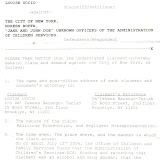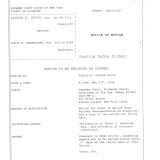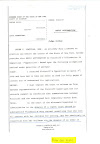It was revealed that at least a couple of the psychiatrists who authored the below mentioned study on antidepressants, suicides and the Black Box warning have close ties to pharmaceutical companies.
http://www.pharmalot.com/2007/09/antidepressants-suicide-and-conflicts-of-interest/
New York Times Experts Question Study on Youth Suicide Rates
By ALEX BERENSON and BENEDICT CAREY
September 14, 2007
Last week, leading psychiatric researchers linked a 2004 increase in the suicide rate for children and adolescents to a warning by the Food and Drug Administration about the use of antidepressants in minors. The F.D.A. warning, the researchers suggested, might have resulted in severely depressed teenagers going without needed treatment.
But the data in the study, which was published in The American Journal of Psychiatry and received widespread publicity, do not support that explanation, outside experts say.While suicide rates for Americans ages 19 and under rose 14 percent in 2004, the number of prescriptions for antidepressants in that group was basically unchanged and did not drop substantially, according to data from the study. Prescription rates for min ors did fall sharply a year later, but the suicide rates for 2005 are not yet available from the Centers for Disease Control and Prevention.
“There doesn’t seem to be any evidence of a statistically significant association between suicide rates and prescription rates provided in the paper” for the years after the F.D.A. warnings, said Thomas R. Ten Have, a professor of biostatistics at the University of Pennsylvania.
In the report published last week, the authors analyzed data on suicides and antidepressant use over several years in the United States and the Netherlands. They argued that drug regulators may have created a larger problem by requiring pharmaceutical companies to place warnings on antidepressants, scaring away patients and doctors. The F.D.A. warning label says that a potential side effect in young people is an increase in suicidal thoughts and behavior.
The most plausible explanation is a cause and effect relationship: prescription rates change, therefore suicides change,” said Dr. J. John Mann, a psychiatrist at Columbia University and a co-author of the study.
But Dr. Ten Have and other experts, while noting that it may still turn out that a reduction in prescriptions is leading to increased suicides among young people, said that the new study neither proved nor disproved this. Instead, some experts say, the study illustrates why suicide trends are so difficult to understand — and why this debate has been so polarizing and confusing.
In an interview, Robert D. Gibbons, a professor of biostatistics and psychiatry at the University of Illinois at Chicago and the lead author of the journal article, acknowledged that the data from the United States that he and his colleagues analyzed did not support a causal link between prescription rates and suicide in 2004. “We really need to see the 2005 numbers on suicide to see what happened,” he said.
But Dr. Gibbons defended the paper, saying that when taken in the context of previous studies that linked falling antidepressant use to increased suicide rates, “this study was suggestive, that’s what we’re saying.”
Other experts, however, said that the problem with such studies is precisely that they are suggestive rather than conclusive and are open to interpretation. Suicides are rare and uniquely personal events that can be driven by many factors: worsening depression or other mental illnesses, breakups or job loss, lack of drug or psychiatric treatment, even easy access to guns.
In calling for the labeling change on antidepressants, F.D.A. scientists based their decision on data from drug makers’ clinical trials, considered the gold standard in medical research. Those trials have shown that young patients who took antidepressants were about twice as likely than those on placebos to report suicidal thoughts or attempts, though the numbers in both groups were small.
Yet none of the youngsters in the trials, most of whi ch ran for no more than a month or two, actually committed suicide. And most psychiatrists with long experience using antidepressants in children say the benefits far outweigh any risk.
In studies of data collected before 2004, Dr. Gibbons, Dr. Mann and others found clear associations between prescription patterns and suicide rates. For instance, prescription rates for patients from ages 10 to 24 rose steadily in the 1990s, while the suicide rate in that age group fell 28 percent from 1990 to 2003, according to a government report released last week.
In another study, researchers at Columbia University, analyzing data from 1990 to 2000, found that for every 20 percent increase in the use of antidepressants among adolescents, there were five fewer suicides per 100,000 people each year. Psychiatric researchers have found similar patterns among some age groups in other countries, including Sweden, Japan and Finland.
But many uncertainties remain. While the suicide rate for adolescents has fallen over the last decade, it has remained largely unchanged for the overall population, though prescriptions for psychiatric medicines have risen sharply in all age groups. Adjusted for the demographic changes, about 11 Americans per 100,000 killed themselves in 2004, the same as in 1994.
Demographics can play a role: White people kill themselves about twice as frequently as African-Americans and Hispanics, so as the population becomes more diverse, the suicide rate ought to drop, all else being equal. And suicide rates also appear to be negatively correlated with economic growth, which was exceptionally strong from 1994 to 2000. Advances in medicine also mean more lives can be saved now.
With so many potentially confounding factors at play, interpreting the relationship between prescription rates and suicides is difficult, said Andrew Leon, a professor of biostatistics at Weill Cornell Medical College who has served on F.D.A. panels study ing suicide risk and antidepressants.
“These kinds of studies are very important in giving us a sense of the rates of disease and death in a population and how those may correspond to other things,” Dr. Leon said. “But what they don’t do is tell us whether the two trends are directly related.”
Original Article - www.nytimes.com/2007/09/14/us/14suicide.html?_r=1&oref=slogin
22,999 people have now signed the petition against TeenScreen!Video:
http://www.youtube.com/watch?v=RfU9puZQKBYPetition:
http://www.petitiononline.com/TScreen/petition.html
Please pass the word far and wide - we still have a lot of work to do - a lot of kids are depending on us!
Subscribe to:
Post Comments (Atom)























No comments:
Post a Comment